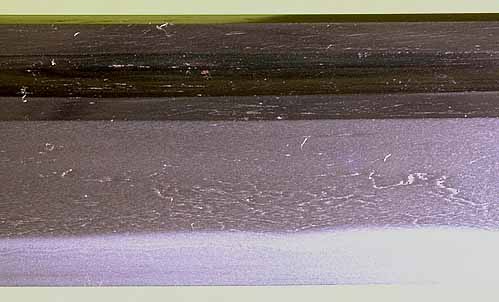

Grain (hada) of a Japanese sword blade inscribed Bitchu ju Yasuyuki saku (mid 14th Century). The paleness of the edge area of this blade is largely due to the polishing technique (hadori) and masks the true hamon ("temper" line) in this photograph. Japanese sword blades show a variable grain structure which arises as a result of folding the billet from which the sword is being formed back upon itself many times (up to, but usually fewer than twenty, which would give just over a million layers). The concept here is simple: when dealing with steel of varying composition, maximum strength may be achieved by averaging weak and strong areas by forming a laminated structure. The repeated working may also partially exclude and break up larger slag inclusions, further reducing potential seeds for failure. The above close-up photograph is of the grain of a 14th century sword by Yasuyuki which lost its tip in antiquity, and which therefore has seen few subsequent polishings. It should be clear that the surface of the blade exhibits a moderately fine wood grain-like pattern, which is exposed as the sword is ground and polished such that the wood grain pattern seen here represents a tangential cut through many layers of steel just as the wood grain in a tabletop represents tangential cuts through a tree's growth rings. The construction of such a sword is likely more complicated, with a cross section revealing different steel at the core than that at the edge, the back, or the sides of the blade.
<Return to previous part ~ Return to Table of Contents ^ ~ Go to next part >